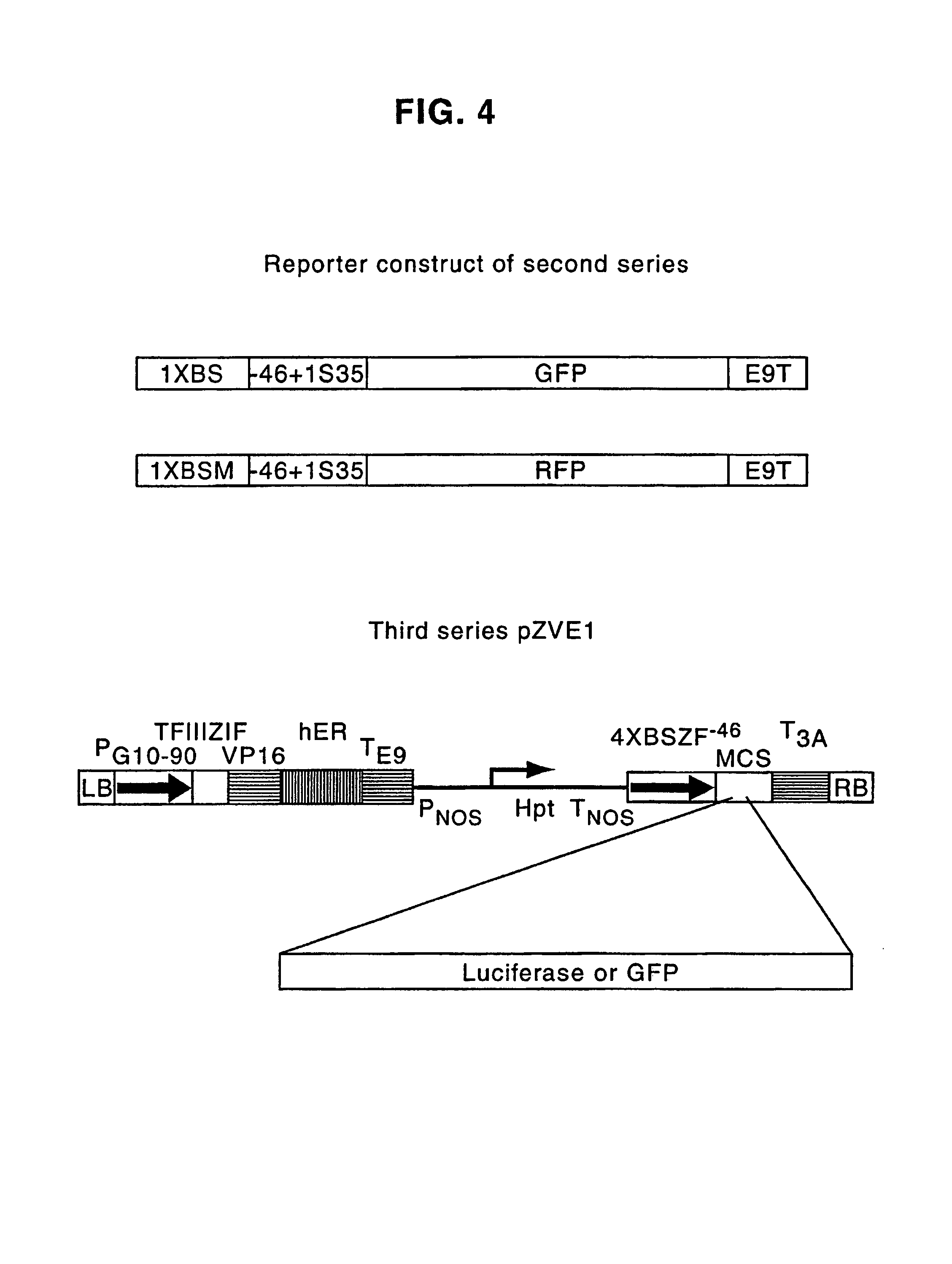Regulated gene expression in plants
- Summary
- Abstract
- Description
- Claims
- Application Information
AI Technical Summary
Benefits of technology
Problems solved by technology
Method used
Image
Examples
example 1
Generation of Transgenic Plants Expressing a Zinc Finger Protein Fused to a Transactivation Domain
[0219]To investigate the utility of heterologous zinc finger proteins for the regulation of plant genes, a synthetic zinc finger protein was designed and introduced into transgenic A. thaliana under the control of a promoter capable of expression in a plant as described below. A second construct comprising the zinc finger protein binding sequence fused upstream of the Green Fluorescent Protein (GFP) reporter gene was also introduced into transgenic A. thaliana as described in Example 2. Crossing the two transgenic lines produced progeny plants carrying both constructs in which the GFP reporter gene was expressed demonstrating transactivation of the gene by the zinc finger protein.
[0220]Using conventional cloning techniques, the following constructs were made as XbaI-BamHI fragments in the cloning vector pcDNA3.1 (Invitrogen).
pTFIIIAZifVP16
[0221]pTFIIIAZifVP16 comprises a fusion of four ...
example 2
Generation of Transgenic Plants Carrying a Green Fluorescent Protein Reporter Gene
[0235]A reporter plasmid is constructed which incorporates the target DNA sequence of the TFIIIAZifVP16 and TFIIIAZifVP64 zinc finger proteins described above upstream of the Green Fluorescent Protein (GFP) reporter gene. The target DNA sequence of TFIIIAZifVP16 and TFIIIAZifVP64 is shown in SEQ ID NO:7.
[0236]This sequence is incorporated in single copy immediately upstream of the CaMV 35S −90 or −46 minimal promoter to which the GFP gene is fused.
[0237]The resultant plasmid, designated pTFIIIAZif-UAS / GFP, is transferred to the plant binary vector pBIN121 replacing the Cauliflower Mosaic Virus 35S promoter. This construct is then transferred to A. tumefaciens and subsequently transferred to A. thaliana as described above. Transgenic plants carrying the construct are designated At-TFIIIAZif-UAS / GFP.
example 3
Use of Zinc Finger Proteins to Up-Regulate a Transgene in a Plant
[0238]To assess whether the zinc finger constructs TFIIIAZifVP16 and TFIIIAZifVP64 are able to transactivate gene expression in planta, Arabidopsis lines At-TFIIIAZifVP16 and At-TFIIIAZifVP64 are crossed to At-TFIIIAZif-UAS / GFP. The progeny of such crosses yield plants that carry the reporter construct TFIIIAZif-UAS / GFP together with either the zinc finger protein construct TFIIIAZifVP16 or the zinc finger construct TFIIIAZifVP64.
[0239]Plants are screened for GFP expression using an inverted fluorescence microscope (Leitz DM-IL) fitted with a filter set (Leitz-D excitation BP 355-425, dichronic 455, emission LP 460) suitable for the main 395 nm excitation and 509 nm emission peaks of GFP.
[0240]In each case, the zinc finger construct is able to transactivate gene expression demonstrating the utility of heterologous zinc finger proteins for the regulation of plant genes.
PUM
| Property | Measurement | Unit |
|---|---|---|
| Gene expression profile | aaaaa | aaaaa |
| Level | aaaaa | aaaaa |
Abstract
Description
Claims
Application Information
 Login to View More
Login to View More - R&D
- Intellectual Property
- Life Sciences
- Materials
- Tech Scout
- Unparalleled Data Quality
- Higher Quality Content
- 60% Fewer Hallucinations
Browse by: Latest US Patents, China's latest patents, Technical Efficacy Thesaurus, Application Domain, Technology Topic, Popular Technical Reports.
© 2025 PatSnap. All rights reserved.Legal|Privacy policy|Modern Slavery Act Transparency Statement|Sitemap|About US| Contact US: help@patsnap.com



